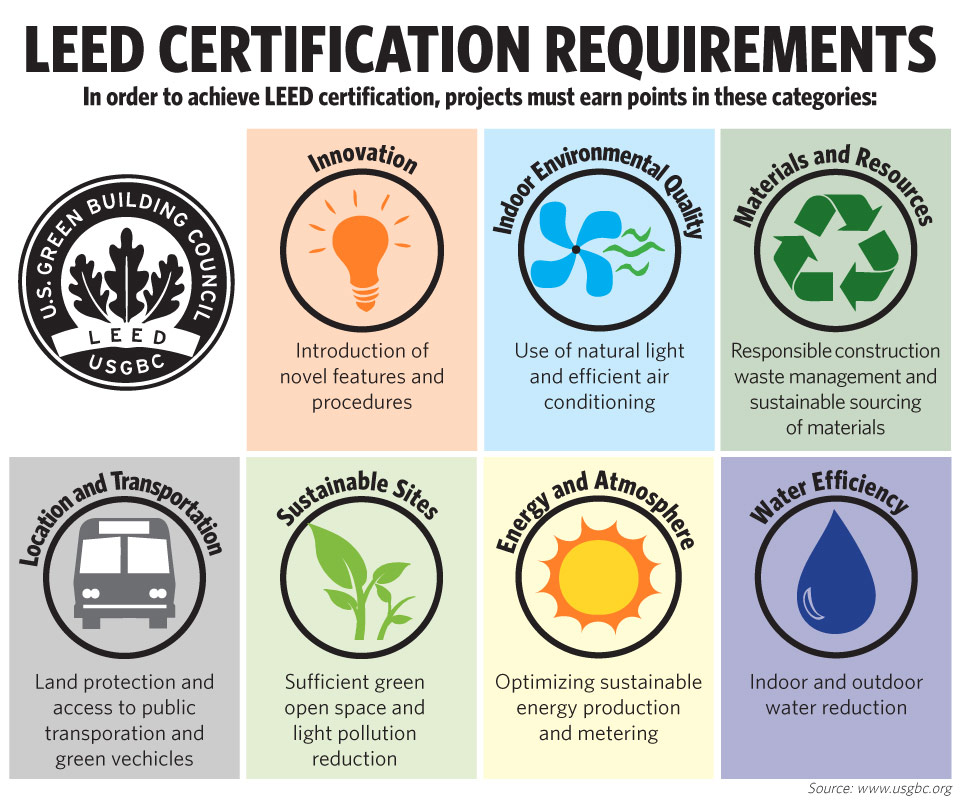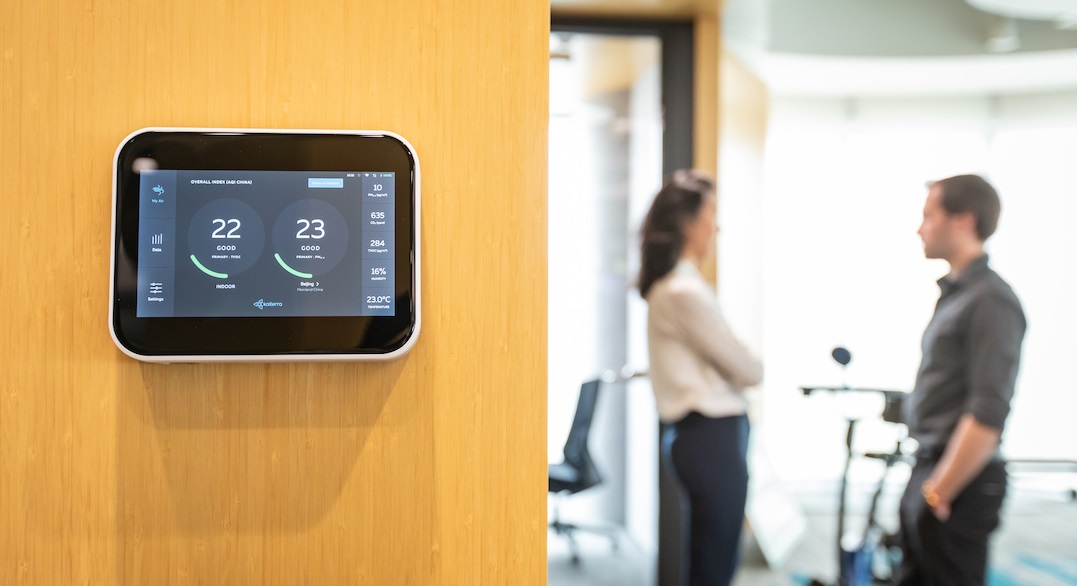Newsletter
Since it was established in the ‘90s, LEED has become one of the world’s leading green building certifications. With a focus on energy savings and sustainability, LEED was established to promote green ideas in building construction, design, and operation.
What Is LEED?
Leadership in Energy and Environmental Design (or LEED, for short) is a building certification program created by the Green Building Council with the goals of promoting greener, energy-efficient buildings.
Like the WELL Standard, LEED has four rating tiers: Certified, Silver, Gold, and Platinum. These tiers are based on the number of points earned towards certification, so if you’re looking to receive a top-level certification, it is crucial to maximize all available points.
Why Indoor Air Quality Is Crucial for LEED
Indoor Environmental Quality (EQ) is one of seven core categories that make up the LEED program. When designing green buildings, it is essential to also take the health of building occupants into account. LEED incorporated EQ to balance these complementary approaches to building design and reward positive design choices that emphasize the health and comfort of building occupants.

Depending on the type of project undergoing assessment, EQ can be worth a significant number of points. Many of the subcategories in Indoor Environmental Quality pertain to air quality. For example, for BD+C, O+M, and ID+C projects, setting air quality performance minimums through ventilation is a prerequisite for certification.
Using Kaiterra Enterprise Products To Earn a LEED Certification
Air quality monitoring can be a great asset when working towards a LEED v4.1 certification and will help you earn points in three main areas: enhanced indoor air quality strategies, indoor air quality assessment, and indoor environmental quality performance.
BD+C & ID+C Projects
Enhanced indoor air quality strategies (1 out of 3 points)
BD+C & ID+C projects can earn up to 3 points through the enhanced indoor air quality strategies credit. This credit contains 10 strategies, each with the goal of improving ventilation, filtration, or indoor air quality of the building’s indoor environment.
Requirements:
Comply with 3 strategies for 1 point or 6 strategies for 2 points.
Continuous indoor air quality monitoring by Kaiterra can help contribute to earning points through achieving strategies 9 and 10 of the enhanced indoor air quality strategies credit.
Strategy 9. Carbon Dioxide Monitoring
CO2 levels must be monitored within all densely occupied spaces. Monitors must be located between 3 and 6 feet above the floor and must have an audible or visual indicator which alerts the building automation system if CO2 levels exceed the setpoint by greater than 10%.
Strategy 10. Additional Source Control and Monitoring
In spaces where you’re likely to find indoor air pollutants, you must monitor and evaluate these sources of air contaminants, separate from CO2. In addition to monitoring, you must also develop and implement a materials-handling plan to reduce the chances of contaminant release. For the specific contaminants or pollutants identified, you must install monitoring systems with sensors designed to track these pollutants. An alarm must alert others of any unusual or unsafe conditions.
Air quality monitoring can help you achieve both of the strategies outlined above. The Sensedge is a RESET-certified commercial air quality monitor, so it meets LEED requirements for carbon dioxide (CO2) monitoring.
Likewise, all of Kaiterra’s commercial air quality monitors are equipped with TVOC and particulate matter sensors and can potentially be equipped with ozone, formaldehyde, nitrogen dioxide, and others. Monitoring these additional parameters will meet the monitoring aspect of “additional source control and monitoring,” helping you achieve the additional strategy.
Between these two strategies, projects of any ventilation type can be on their path toward earning points under enhanced IAQ strategies with Kaiterra’s commercial monitors.
Indoor air quality assessment (2 points)
For ID+C and BD+C projects (except for BD+C: Core & Shell), another opportunity to earn points is through an indoor air quality assessment. The goal of this credit is to establish better air quality once construction is completed and during building occupancy. There are two options to achieve points: flush-out and air testing.
Flush-out is worth one point and deals with ventilation. To earn this credit, the interior of the project must be flushed-out after construction is complete, but before building occupancy begins. Alternatively, if occupancy begins before the flush-out is complete, then a flush-out period must occur before each time the building is occupied.
In either flush-out path, temperature and relative humidity must be at least 60℉ (15℃) and no higher than 60%, respectively. Kaiterra’s commercial air quality monitors are equipped with dry-bulb temperature and relative humidity sensors, which can help you during flush-out.

Your project's flush-out path will depend on your occupancy timeline, but temperature and relative humidity must be kept within target either way.
The second option, air testing, is an IAQ spot check after construction but before building occupancy. One point is awarded for a check of particulate matter and inorganic gases (carbon monoxide and ozone), and another point is awarded for a test of volatile organic compounds.
With Kaiterra’s Sensedge and Sensedge Mini, you can continuously monitor particulate matter and TVOC, which can help meet air testing requirements. Additionally, if air quality tests aren’t sufficiently healthy for building occupation, then re-tests are necessary to earn points under indoor air quality assessment. Continuous air quality monitoring can save time and money normally used on re-testing, and you will immediately know when air quality conditions meet LEED’s specifications.
O+M Projects
Indoor Environmental Quality Performance
Until now, we’ve mainly discussed BD+C and ID+C projects. What about Operations + Management (O+M) projects?
In LEED v4.1, O+M projects can earn points through the indoor environmental quality performance credit, which features a combination of air testing and occupant surveying. Previously worth 9 points, in the new v4.1 update, the indoor environmental quality performance credit is now worth up to 20 points. This marks an enormous change in the prioritization of air quality by LEED, and projects that follow this IAQ trend can earn major points.
O+M projects must use an annual survey and annual air test to calculate a Human Experience Score, which is based on:
- Occupant satisfaction score (50% weighting)
- CO2 score (25% weighting)
- TVOC score (25% weighting)
Once the Human Experience score is calculated, it is matched up to its corresponding point allotment. A score of at least 40 is required and is worth 8 points.
| Human Experience Score | LEED Points |
| 40 (required) | 8 (required) |
| 43 | 9 |
| 48 | 10 |
| 53 | 11 |
| 58 | 12 |
| 63 | 13 |
| 68 | 14 |
| 73 | 15 |
| 78 | 16 |
| 83 | 17 |
| 88 | 18 |
| 93 | 19 |
| 98 | 20 |
At least one air quality evaluation is required per year, and the costs of testing can add up. One way to save money in the long-term and complete the air quality evaluation component is to continuously monitor the required air pollutants. As we mentioned above, all of Kaiterra’s commercial air quality monitors continually keep tabs on particulate matter, TVOC, and CO2, helping you earn up to 20 points towards certification without the hassle of annual testing.
Securing a LEED certification takes time and effort, but it's well worth it in the end. To find out more about air quality monitoring options tailored to your project’s needs, reach out to our team below:






.png?width=200&height=148&name=Menu%20C%20(2).png)

.png?width=307&height=228&name=Menu%20-%20D%20(1).png)
.png)





